Check out my custom vibration dampener
Wilson Clash 100 v2
Review & Playtest
We hope you love this article. Just so you know, TennisCompanion may collect a small share of sales from the links on this page to help keep this site running. Learn more. Disclosure: Wilson gave me this frame to evaluate, but they did not pay me to write this review or influence its contents.
Three years after its initial release, Wilson debuts the Clash 100 v2 for 2022, a refinement on their innovative first generation that sought to blend greater flex for comfort while retaining power. A rare combination, especially for a mid-weight racquet.
Although the racquet won’t appeal to every player, those that convert are often raving fans who praise the frame for its well-balanced performance and responsive comfort.
The Wilson Clash 100 v2 retains much of the prior generation’s formula, but the update strives to enhance stability for a more consistent response while increasing the sweet spot’s size.
I’ll share my thoughts on the racquet’s new design, its ideal string setup, and how it performs on the court so you can decide if it’s a good fit for your game. Finally, to round out this review, I’ll provide you with upgrade advice based on the changes from the prior model.
| Popular Clash Models |
| Wilson Clash 98 v2 |
| Wilson Clash 100L v2 |
| Wilson Clash 100 v2 |
| Wilson Clash 100 Pro v2 |
| Wilson Clash 108 v2 |
I won’t dive into the specs, technical features, or alternatives to consider in this review. However, I’d encourage you to check out my Wilson Clash 100 v2 product page if you want to explore those.
While you’re here, you might consider checking out my reviews on the Wilson Clash 98 v2, Clash 100 Pro v2, and Clash 108 v2.
Article Contents
Click below to jump to a section
Tap below to jump to a section
Design
Strings & Tension
Performance & Ratings
Groundstrokes
Volleys
Serves
Returns
Summary
Upgrade Advice
New to TennisCompanion?
Create a free account and explore my latest videos below
Design
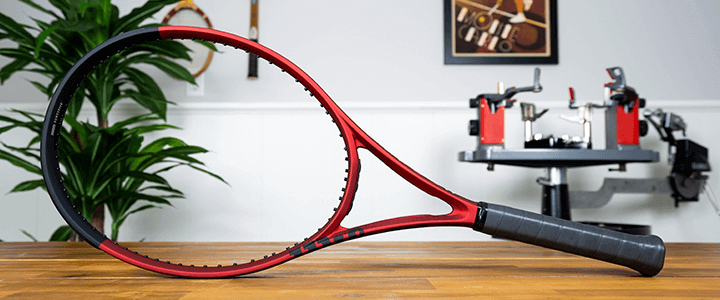
At first glance, one of the Wilson Clash 100 v2’s most significant changes is its cosmetic or paint job. As you may have guessed, this change has no bearing on the racquet’s performance.
However, many players heavily weigh a racquet’s design, so I like to detail the changes and share my take on them.

The first generation adhered pretty closely to the design of Wilson’s other performance racquet lines. Black at the bottom, grey in the middle, and a pop of color at the top.

It’s a clean design, but it lacked a bit of punch. I wasn’t a big fan of the neon infrared highlight, but it didn’t bother me either. Overall, I had a fairly neutral attitude toward the design.
Last year, things changed. Starting in 2021 with the Blade v8, Wilson headed in a new direction with their paint jobs, and the Clash v2 continues with that trend.

The Wilson Clash 100 v2 gets a complete makeover retaining red as the core color but switching to a darker red with a matte finish and black to complement the look, which I think looks awesome.

Although the color is matte, it has does reflect a bit of light, which Wilson refers to as an anodized elastic finish. It’s soft to the touch with a rubber-like grippy texture that feels good in the hand.
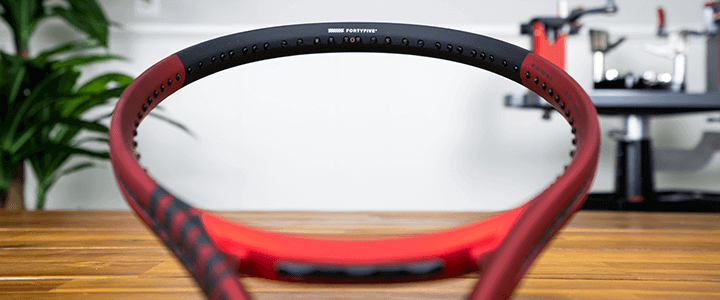
Starting at the tip of the racquet’s hoop, you’ll find a solid black matte finish with the racquet’s FourtyFive construction called out as a silver highlight, which is a nice touch.

The rest of the racquet is red with black writing. On the inside edge toward the middle of the frame, you’ll find the racquet’s specs, including weight, recommended tension, balance, string pattern, head size, and stiffness index listed. The prior generation didn’t include these, but I prefer when they’re present.

Working your way down the racquet’s throat, you’ll find the Clash logo debossed or stamped into the frame, which provides for a fresh new look that you won’t find on many other racquets.
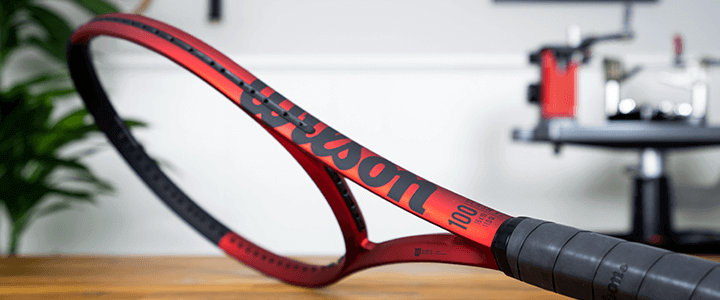
On the other side, Wilson wraps their logo around the edge and prints the model details along with the string pattern and stiffness index once again. These elements are typical and look clean.

At the bottom of the racquet, you’ll find a red butt cap with Wilson’s logo in black. I wish they printed the grip size directly on the butt cap as is relatively standard practice, but it is printed on the inside of the handle if you pop off the trap door.
Strings & Tension

To enhance the Wilson Clash 100 v2’s spin and control for my playtest, I strung the racquet with 17 gauge or 1.25 mm Luxilon ALU Power at 55 lbs (24.95 kg).
Luxilon Alu Power is the polyester tennis string that Wilson recommends as a pair with the racquet along with a tension somewhere between 50 – 60 lbs (22.68 – 27.22 kg).
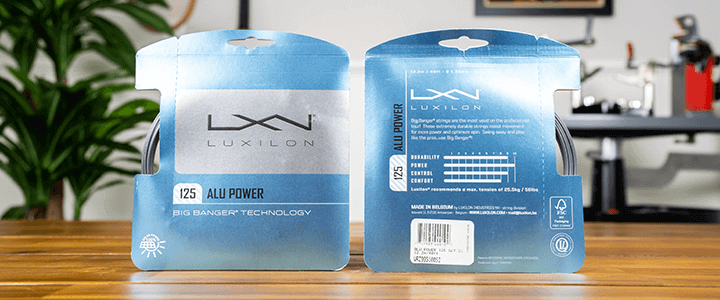
Luxilon Alu Power is a solid recommendation for many intermediate to advanced players, which I think pairs well, and is one of my picks for the best tennis strings.
However, my main concern is players gravitating to the Wilson Clash 100 v2 for comfort. If that’s you, I’d recommend against Alu Power by itself because its stiffer response will reduce the racquet’s comfort, which is counterproductive for you.
As an alternative, you might consider stringing Luxilon Alu Power as a hybrid setup with a softer multifilament or natural gut like Wilson NXT or Babolat VS Touch. Plus, since the mains will dominate the overall feel, I’d encourage you to string with the softer string in the mains.
Performance & Ratings

Although a racquet’s specs and construction can go a long way to help you understand how a racquet will perform, there’s no substitute for hitting with or demoing a racquet for gaining a feel for its performance.
However, as you read the opinions or thoughts about a particular racquet, it’s helpful to have some background on the player reviewing the racquet, which helps add some context.
I’ve included some of those notes below, but you can also read my tennis bio here if you want to learn more.
| Main Strings | Luxilon ALU Power (1.25 mm) |
| Cross Strings | Luxilon ALU POwer (1.25 mm) |
| Mains Tension | 55 lbs / 24.95 kg |
| Crosses Tension | 55 lbs / 24.95 kg |
| Forehand Grip | Semi-Western |
| Backhand | Two-handed |
| Grip Size | #3 – 4 3/8 |
| Grip | Wilson Pro Performance |
| Overgrip | Wilson Pro |
| Weight | 165 lbs / 74.84 kg |
| Height | 6’0″ / 1.83m |
To provide you with the most objective review possible, I’ve rated the Wilson Clash 100 v2 across twelve different performance criteria. It’s the same rating system I use for all my racquet reviews so that you can use them as a basis for comparison.
The following sections provide extra details on why I gave the above scores broken out by groundstrokes, volleys, serves, and returns. I’ll wrap things up with a quick summary.
Groundstrokes
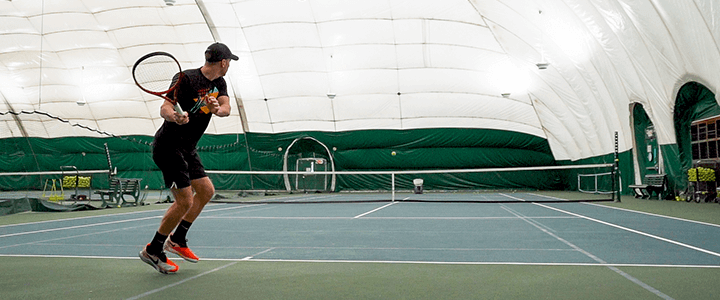
From the baseline, the Wilson Clash 100 v2 is at its best.
It’s a fast-swinging 10.4 oz (295 g) tennis racquet that enabled me to generate plenty of topspin, aided by the frame’s mid-sized 100 in² (645 cm²) head size and open 16×19 string pattern.
The racquet doesn’t overwhelm with power, but it doesn’t disappoint in this area either. I found I could swing aggressively with added topspin providing excellent control and helping maintain a higher margin for error over the net.
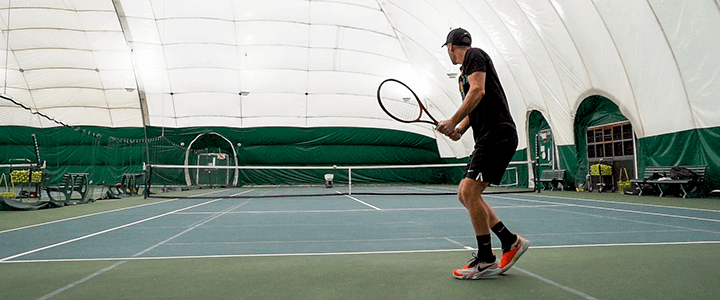
For the most part, the frame’s stability is plenty sufficient. However, I did find the racquet to have a harder time facing a heavier ball, which is roughly on par with the prior generation, so you’ll want to consider that based on your skill level.
With that said, I don’t expect it will be an issue for most intermediate players considering this frame. Furthermore, you can add a bit of weight at 10 and 2 o’clock at the racquet’s head to improve this attribute. Alternatively, you might consider opting for the Wilson Clash 100 Pro v2, which is heavier and more stable.

The Wilson Clash 100 v2’s comfort is excellent, and it remains one of the frame’s standout features, which is a nice departure from some of the popular stiffer frames.
Hitting slice, I thought the racquet was acceptable, but I don’t think it’s going to wow you either. The ball tends to float or sit up a bit, so that may require a bit of adjustment for you.
Volleys
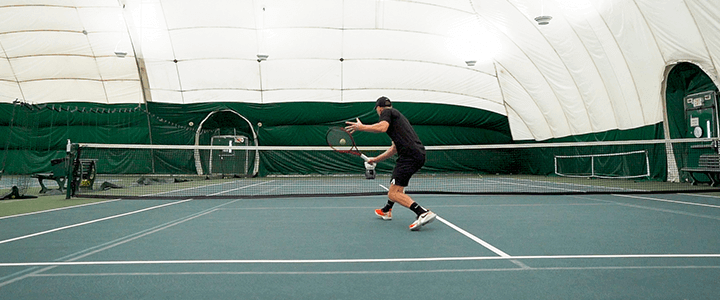
At the net, the Wilson Clash 100 v2’s highlights include easy maneuverability and plenty of power to put away the ball.
However, like the prior generation, I thought the frame felt a bit too lively when hitting volleys, sacrificing a bit of precision and making it a bit more challenging to execute touch shots with confidence.
I found the racquet’s stability suffers due to its lower weight when facing extra pace. It’s not a poor performer up at the net, but it’s not the racquet’s strong point either.

You’ll need to consider your skill level once again on this front. Most intermediate players will likely find the racquet is adequate when hitting volleys, but as you face stronger competitors, the need for extra stability will likely become more apparent.
Although adding weight to the frame is a reasonable solution, doing so will be best suited for strong intermediate to advanced players who prefer the specs of this model but desire added stability and can comfortably manage the extra weight.
Serves

Hitting serves, I thought the Wilson Clash 100 v2 delivered a well-rounded performance, enabling plenty of variety in the execution of different types of serves along with sufficient power.
The racquet’s manageable weight allowed me to swing fast to generate excellent spin for a kick or slice serve. However, it’s not going to give you maximum free power for a huge flat serve. You’re trading that for the extra comfort, which is apparent serving.
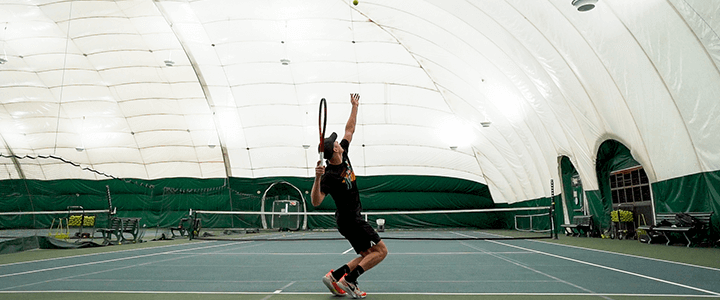
As far as precision goes, I thought it handled well. I found I could reliably hit my spots and a strong sense of consistency overall.
Returns
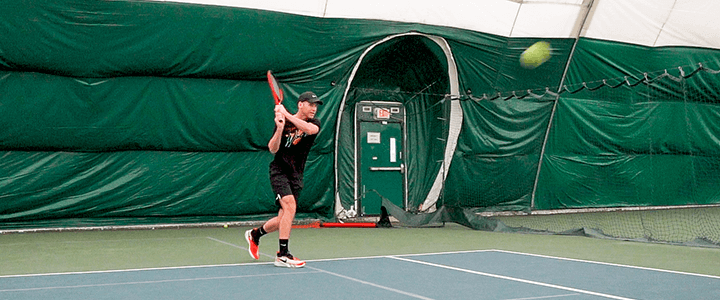
When hitting returns, I appreciated the Wilson Clash 100 v2’s head light balance and moderate weight for easy maneuverability, ensuring I could quickly get the racquet into position.
Once again, I thought the racquet’s lower stability to become a bit of an issue when facing a heavier serve, but there is a distinct difference compared to volleys. More specifically, I had the opportunity to generate momentum before striking the ball, so it held up pretty well, especially considering its weight.

Combined with what I found to be an improved sweet spot over the first generation, I thought it performed well on returns.
Summary
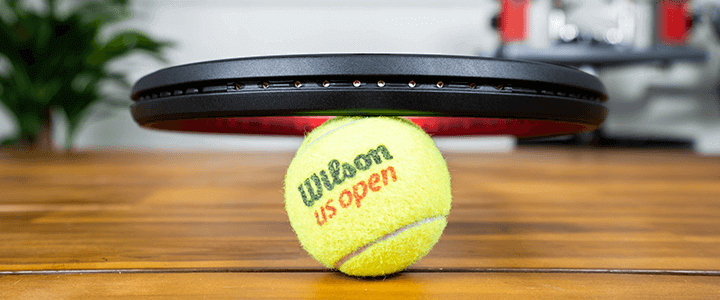
The Wilson Clash 100 v2 is a terrific high-comfort frame that delivers a solid all-around performance with intermediate players as its sweetspot but is perfectly adequate for advanced players looking for a lighter option with room for customization.
It stands out on the baseline with an excellent blend of spin for control and power, especially for those that desire performance in these areas but demand comfort as well.
Like the original model, my favorite part about the Wilson Clash 100 v2 remains its broad appeal that will suit a wide range of players and styles. Even beginners looking to ditch their inexpensive frames and step into a quality frame they can grow into, and that’s not too demanding will find it worthy of consideration.
| Popular Clash Models |
| Wilson Clash 98 v2 |
| Wilson Clash 100L v2 |
| Wilson Clash 100 v2 |
| Wilson Clash 100 Pro v2 |
| Wilson Clash 108 v2 |
Upgrade Advice
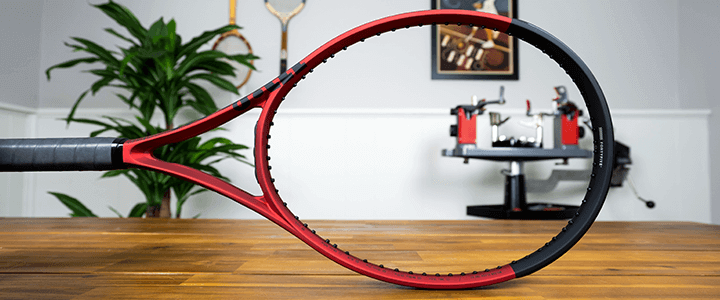
If you’re currently using the Wilson Clash 100 v1 and considering an upgrade, then I’d say it comes down to a few factors.
Stability & Consistent Response
When comparing the original model to the latest generation, Wilson’s most significant performance change is its revised construction at the tip of the hoop.
I found some mild improvements when comparing the v1 and v2 side by side, which was most noticeable, hitting groundstrokes and returns. The v2’s response felt slightly more stable, translating to a more consistent response that’s better than the prior model.
By itself, this minor improvement isn’t enough of a change to make a strong recommendation for spending the extra money to upgrade if your current frames are in good condition.
However, if your primary concern with upgrading is the latest generation taking a step backward, then that’s not something you’ll have to worry about – it’s solid.
Design
Hands down, the most significant change to the second generation of the Wilson Clash 100 is its cosmetic or pain job. Wilson has taken the frame’s design in an entirely new direction, which I think is a significant improvement over the prior model.
Of course, the design changes have no impact on performance, but if you like the racquet’s new look and love the current model, I’m confident you won’t be disappointed upgrading.
Environmental Impact
From their Trinity tennis balls to the Clash 100 v2’s new Agiplast plant-based bumper, grommets, and butt cap, Wilson continues to make an effort to reduce its environmental footprint.
I applaud Wilson for the effort and hope more tennis brands follow suit. Although these are seemingly small changes, they add up over time, and it’s great to see them making a concerted effort.
If environmental causes are important to you, then I’d say that’s a decent reason to upgrade and support Wilson’s continued efforts, especially if your old racquet needs replacement.
Of course, if you do upgrade, make sure your old racquet doesn’t make it to the trash, and you hand it down to someone else who can use it or keep it as a solid backup.
Wrapping Up

In 2022, Wilson keeps a good thing going with their high comfort all-around performer, the Clash 100 v2.
I’m happy to see the racquet found success over the past three years because I think the market needs a handful of mainstream options that cater to players suffering from arm discomfort.
Although the racquet is not for everyone, it’s an excellent option that remains a relatively easy recommendation for various players and levels, and I expect its popularity to continue growing.
Play Better Tennis
Improve your game alongside our community of tennis players
Why join?
Discussion Boards
Join the conversation with other members of the community.
5 Point Friday
Read our weekly recap of the 5 most interesting things we dig up in tennis.



Leave a Reply
Want to join the discussion?Feel free to contribute!